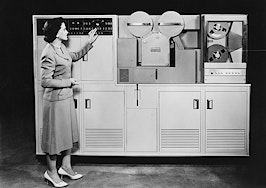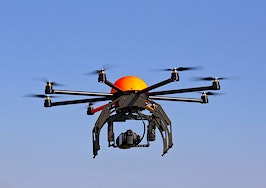I always look forward to writing a tech prediction article at the end of year. It’s my favorite type of piece. The research is fascinating, and, for me, analyzing trends and patterns is just plain fun. So, without further ado, here are my top 10 tech trends for 2014.
10. BYOD (bring your own device)
As I mentioned in “The pros and cons of a ‘bring your own device’ brokerage office,” the launch of the iPhone forever changed mobile computing and ignited the BYOD revolution. Information technology (IT) departments are now expected to seamlessly support a plethora of devices brought into the workplace by employees. While not as sexy as other tech items on this list, the bring-your-own-device culture will nevertheless continue to grow in 2014, and wearable technology will be thrown into the mix.
9. Mobile video
Every year I find myself writing, “This will be the year video tips in real estate.” Not this year. I believe it’s already tipped. In 2014, mobile video makes a big dent and the technology positions itself as an effective mobile marketing strategy.
I touched base with Christian Sterner, founder of WellcomeMat, to get his thoughts on mobile video. “Mobile video is interesting for so many reasons, but a theory that WellcomeMat is acting on is that mobile users need to have access to ‘lean-back content’ just to continue navigating their daily missions,” Sterner said.
“Reading is just harder to do when you are on the go, and this is a large value proposition for full-motion video and auto-created animations for listings. There is something to be said for the flexibility of video — viewers can listen to the audio and/or watch the videos you provide. They do not have to consume their eyes and brains focusing on text, and for those reasons we think mobile video is going to win the day in real estate.”
8. Beacon-based sensors
Beacon-based sensors such as Apple’s iBeacon enable hardware to send notifications to mobile devices in close proximity. The technology integrates Bluetooth low energy and presents marketers with a huge opportunity if the platform can be executed properly. TechCrunch recently reported that Apple could have up to 250 million units rolled out in 2014. Apple isn’t the only tech giant interested in developing beacon-based technology. Google and Microsoft are making strides in the space as well. Look for a major breakthrough in 2014.
7. App store optimization
Here’s another acronym to add to the growing list of industry buzz terms: ASO. ASO stands for App Store Optimization and is the practice of increasing the visibility of apps in stores such as iTunes and Google Play.
With more than 1 million apps available in Apple’s App Store alone, there is fierce competition for downloads and building a user base. As an app developer and publisher, leveraging reviews, optimizing your apps ranking and topping the charts will be a critical imperative in 2014.
6. The maker movement
The maker movement, entrenched with a strong DIY mentality, will have a major impact on the tech scene in 2014. Some consider 3-D printing nothing less than the reinvention of manufacturing. As “additive manufacturing” technology improves and becomes more affordable, it cannot be ignored. Within the next few years, I envision every office sporting a 3-D printer, and that includes the real estate industry.
Products such as the Raspberry Pi and Arduino have captured the imagination of many in the maker movement community and will continue to spark creativity in 2014.
5. 3-D environments
Joel Burslem of 1000watt recently wrote that 3-D environments are online real estate’s next dimension, and I tend to agree with him. In the article, Burslem describes the immersive 3-D experience that platforms such as Floored deliver.
Burslem noted: “Technologies like Floored, Photosynth or movies like ‘Frozen’ show us that a truly virtual reality, whether presented on screen as entertainment or as experienced when marketing real estate, is no longer the stuff of science fiction.”
I am seeing 3-D environments find their way into other touch points that directly impact real estate including maps and SEO (Search Engine Optimization). Google “Inside View” is a perfect example. Inside View allows a user to virtually tour a business from the inside. The experience is pretty cool and seamlessly enables a user to travel from the maps street view to inside. As 3-D technology grows and becomes more feasible in 2014, so will its popularity.
4. Drones
Earlier this year, I purchased a DJI Phantom Quadcopter and mounted my GoPro camera to the device. Needless to say, it was a learning experience. Drones and UAVs (unmanned aerial vehicles) are a polarizing topic. However, the positive attributes they present will have an impact on the real estate industry.
Matt Murphy, founder and president of Boston Virtual Imaging, suggests that the public perception of drones has been influenced by media reports about how this technology has been used in Afghanistan, Iraq and other conflict zones.
“The term drone tends to conjure up thoughts of these machines being used for military purposes,” says Murphy. “The truth is that model aircraft and remote-controlled aircraft have been used for decades in this country by communities of hobbyists with good intentions.”
How will drones be used in real estate in 2014? Murphy believes the most immediate positive result for the real estate industry is that camera-equipped UAVs will allow people to tell stories about listings in ways that they could not previously do.
There is a lot of gray area in terms of the commercial use of drones. In fact, Congress has issued a deadline to the FAA requiring that the agency issue regulations and guidelines by 2015 to allow for integration of commercial UAVs into the national airspace system.
There’s no doubt drones will continue to be a hot topic in 2014. Want to learn more about drone technology, the legalities and FAA policy? Be sure to check out Matt Murphy’s drone workshop at Real Estate Connect New York City in January.
3. Wearable technology
I have to admit, wearable technology hasn’t had the smoothest entry into the marketplace. Products such as Google Glass have drawn criticism and have been the brunt of many late-night TV show jokes. Not to mention, incredibly awkward advertising hasn’t helped matters.
However, new tech products are often met with apprehension. Wearable tech (Pebble, Fitbit, Galaxy Gear) will continue to gain momentum in 2014 and will most definitely find its way into the office, further challenging the IT infrastructure of a BYOD work culture.
2. Internet of Things
The “Internet of Things” could be the most disruptive tech trend of 2014. It also has the potential to be a multibillion-dollar movement. In fact, it could be substantially more . IT research and advisory company Gartner predicts that “the total economic value add for the Internet of Things will be $1.9 trillion in 2020, benefiting a wide range of industries such as health care, retail and transportation.”
Smart connected devices such as the Nest Protect smoke alarm and Goji Smart Lock are reimagining traditional appliances by incorporating elegant designs and connecting to the Internet. Still not convinced connected devices are the wave of the future? In his book “Physics of the Future,” theoretical physicist Michio Kaku envisions a home equipped with a bathroom that has “more sensors than a modern hospital, silently detecting cancer cells years before a tumor forms.” Think about that for a moment.
1. Big data
Big data is a nebulous term to many real estate pros. It is simply a term utilized to describe various data sets that can be accessed quickly and efficiently — for example, housing trends, census data or demographic information.
Big data is going to have a significant impact on technology in 2014, particularly in the real estate industry. NAR recently hired Todd Carpenter to build a new predictive analytics department.
Carpenter said NAR hired him to create a new department that focuses on listening to members and consumers.
“Instead of listening to words, we’re listening to actions. Our goal is to find patterns in those actions that will help us make business decisions to better serve our members,” said Carpenter.
How will NAR leverage big data in 2014?
“2014 will be focused largely on getting the most out of the data we already have,” he said. “That means an increased level of collaboration between the association’s departments. Then, looking for opportunities to personalize our communications, marketing and services to better serve each individual member.”
How have my predictions stacked up in the past? Check out my “5 mobile trends to watch for in 2013” and “Top 10 real estate tech trends for 2012.”
Tom Flanagan is the director of information technology at Residential Properties Ltd. in Providence, R.I. You can contact him at tflanagan@residentialproperties.com or @tflan on Twitter.







